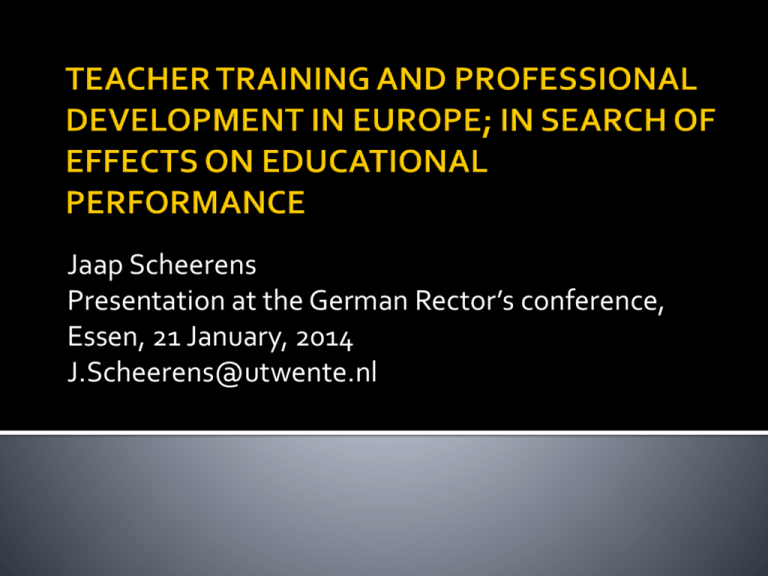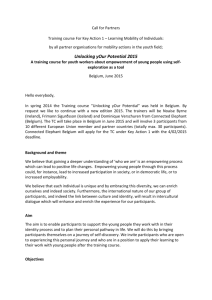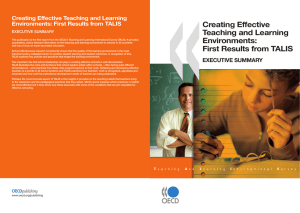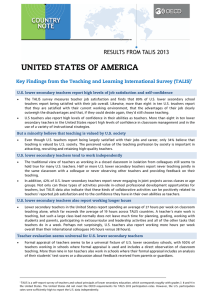Teacher Training and Professional Development in
advertisement

Jaap Scheerens Presentation at the German Rector’s conference, Essen, 21 January, 2014 J.Scheerens@utwente.nl Interesting variations in description and perceptions of teacher training and development across EU countries How important are these variations for differences in educational performance? The answer: apparently not very much, but what is behind this, and how should this conclusion be further qualified? Initial teacher training in EUROPE Results from macro (country) level studies Micro-level studies addressing teacher training effects Continuous Professional Development Conclusions Figure A1: Structure of Initial Teacher Training Education for primary and lower secondary education. Source EU, 2013 Figure A2b: Level and minimum length of initial teacher training for lower secondary schools Source, EU (2013) Other relevant descriptive characteristics: Length of practical training as part of ITT Relative duration of subject matter mastery and pedagogy Descriptive variations obviously do not say anything about effectiveness, yet, examples from other countries might inspire effectiveness enhancing reforms, e.g. - Thinking about more pedagogy in TT in France - Practical TT in England - Introducing any form of teacher appraisal in the Netherlands Facet of school resources Positive impact Proportion of teachers with a third level qualification Belgium, Germany, Switzerland and the United Kingdom (2000) ---------------Austria, Slovenia (2013) OECD, 2005, Figure 3.8, PISA, 2000 data, OECD, 2013 table IV 1 12c ETS (2010): filters used along the teacher education and development pipeline Concurrent/ Consecutive Bachelor/ Master Number of selection methods applied Finland Mixed M, 5 years 4 NL Mixed B, 4 years 2 Poland Mixed B, 4 years 1 Belgium Concurrent B, 4 years 2 Germany Concurrent M, 3 ½ year 1 Selective recruitment Salary Multiple System’s career paths, control and bonuses performance evaluation Training Singapore Top 30% high school Average Yes Yes ? Finland Top 20% high school Modest No No “rigorous” Korea Top 5% college entrance Highest in the world ? modest ? At country level there is no substantial evidence of a teacher training effect, in terms of quantity, level, and organization. No comparable information on TT content. Apart from the very weak methodology, this lack of effects is probably due to the limited variation in teacher training facilities across countries Teachers matter, but which changeable (trainable) teacher characteristics determine teacher quality? This is the question of teacher effectiveness (1), which should not be confused with teaching effectiveness (2) Re 1) relatively stable dispositions and behavioral repertoires Re 2) manifested processes In educational research we usually have to do with naturally occurring variation to make inferences on the effects of schools and teachers. Overall effects of schools or teachers indicate what it matters whether a student goes to school A or school B, or is taught by teacher A or B, i.e. expressed as the amount of total variance in student achievement “explained” by schools or teachers School effects are in the order of 8- 10 %, after adjustment for student background Teacher effects are in the order of about 15% (Impression from various studies) School effects may be seen as containing teacher effects; Luyten, 1994 found that about ¾ of the school effect depended on teacher/subject effects Literally hundreds of research studies have focused on the importance of teachers for student achievement. Two key findings emerge. First, teachers are very important. No other measured aspect of schools is nearly as important in determining student achievement. Second, it has not been possible to identify any specific characteristics of teachers that are reliably related to student outcome. (Hanushek, 2010) Hattie, (2009, ch.7) reports an overall teacher effect of d = .35, an effect of teacher training of d = .11, and teacher subject matter knowledge, d = .09 Walsh (2001) “there is no evidence that school systems should reward teachers for obtaining master’s degrees outside a subject area or that teachers should feel compelled to obtain such degrees. This is a firm conclusion of the research. Given the inability of formal teacher preparation to produce measurable results, policymakers should be skeptical about a strategy for improving teaching that relies on changes in formal pre-service education” Wayne and Youngs (2003) “In the case of degrees, coursework, and certification, findings have been inconclusive, except in mathematics” Goldhaber en Hansen, (2010) “Studies typically find that less than 10 percent of the variation in teacher effectiveness can be attributed to readily observable credentials like degree and experience levels” Walsh (2001) “The teacher attribute found consistently to be most related to raising student achievement is verbal ability. ” The importance of the overall teacher effect and the lack of solid knowledge on malleable teacher characteristics suggest a selection over an ITT and CPD improvement strategy Some results from TALIS, 2009 Characteristics of CPD in high performing countries Some results from micro studies Teachers’ Professional Development. Europe in international comparison J. Scheerens, (ed.) European Union, 2012 Participation Percentage of teachers who undertook some professional development in the previous 18 months % EU Non-EU Averages 100 90 80 70 60 50 40 30 20 10 Turkey Slovak Republic Denmark Iceland Brazil Italy Portugal Norway Hungary Bulgaria TALIS Average EU (TALIS) Average Ireland Belgium (Fl.) Poland Mexico Malaysia Korea Estonia Malta Lithuania Austria Australia Slovenia Spain 0 While 89% of teachers report that they had taken part in "structured professional development activity" over the last 18 months, it is a source of concern that more than 25% of teachers in Denmark, Iceland and the Slovak Republic report they have participated in no professional development at all during this period (Source: EU 2010). Participation and perceived impact of professional development activities Types of professional development Participation % Impact 100 90 80 70 60 50 40 30 20 10 0 Courses and workshops Education conferences and seminars Professional development network Individual and collaborative research Mentoring and peer observation Observation visits to other schools Qualification programmes It is striking how positively teachers view the impact of all development activities. However, fewest teachers participate in the types of development (qualification programmes, collaborative research) which they deem to have the highest impact. More detailed analysis show that experienced impact depends on time spent and variation in participation. Duty or Optional PD plans obligatory Responsibility for PD monitoring Finland Duty Not Not regulated NL Optional Not Not regulated Poland Necessary for promotion Compulsory Local/regulated Belgium Duty Compulsory Local/Inspection Germany Duty Not Top/inspection Mixed results from individual studies and metaanalyses on professional development effects: Timperley et al. (2007) cited in Hattie, 2009, p. 120 report an average effect size of d = .66 Garet et al, (2008) and Garet et al. (2010) report no significant effects of intensive PD programs Lomos et al. (2011) found an overall effect size of d = .22 for the effects of “professional learning communities” Continuous professional development could be seen as a more flexible lever for enhancing student performance. Results from meta-analyses are mixed, but educationally significant effects from program evaluation studies appear to be feasible Joint effects of teacher composition and good training practice mean that better training can easily follow in the wake of higher selectivity (but what about equity?) There is likely to be underutilized potential in making the work of teachers more evidence based (using the knowledge base of teaching effectiveness), with initial training and continuous professional development as important vehicles to realize this. Subject matter mastery Rich repertoire of teaching strategies Deep understanding of learning and motivating students Able to work in highly cooperative ways Strong skills in technology and use of technology Teachers as researchers Structure and classroom management e. g. opportunity to learn Supportive classroom climate e.g. appropriate expectations Cognitive activation e.g. thoughtful discourse Higher effect sizes for “teacher as activator”, (direct instruction, meta-cognitive strategies, feedback) as compared to “teacher as facilitator” (e.g. inquiry-based teaching, individualized instruction) There are important “other” reasons to care about optimizing teacher training and teacher professional development than effectiveness: modernization (ICT applications) coping with new challenges (like inclusive education) improving quality of life, and moral support of teachers Align teacher training and development policies with other “teacher strategies”, including (next to training and development) recruitment, induction and working conditions of teachers at large. Align teacher policies with other levers for educational improvement, like curriculum strategies and evaluation and assessment strategies.










